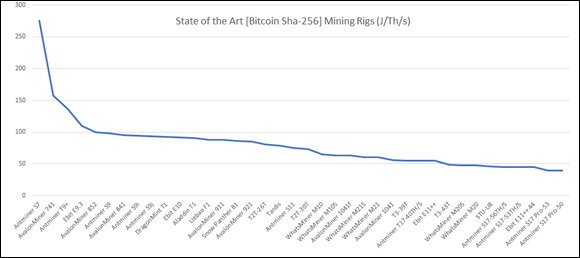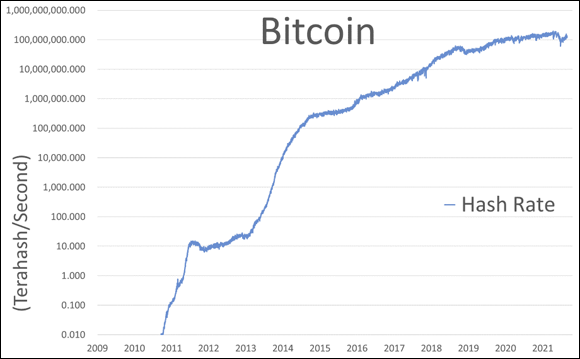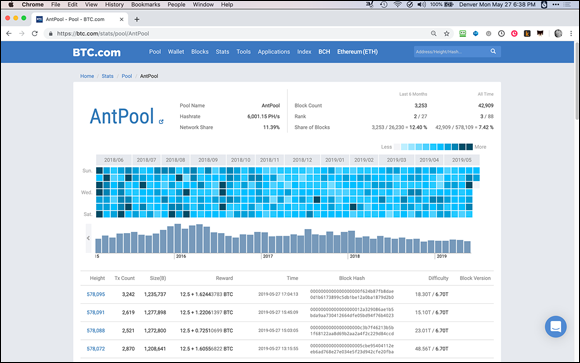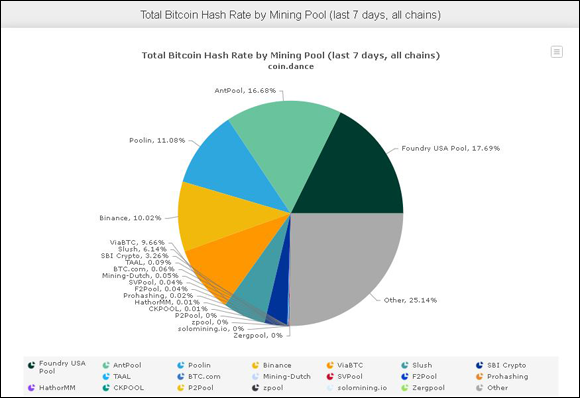Chapter 5
The Evolution of Mining
IN THIS CHAPTER
![]() Learning about the evolution of Bitcoin mining
Learning about the evolution of Bitcoin mining
![]() Working with blockchain
Working with blockchain
![]() Looking back at the era of solo mining
Looking back at the era of solo mining
![]() Working with a mining pool
Working with a mining pool
![]() Working with a cloud mining operation
Working with a cloud mining operation
For the first few years of Bitcoin’s existence, the network was not widely known, and very few users were running nodes or mining. The hardware used to mine was also very basic: general-use computer equipment not designed specifically for mining. Due to this, the amount of computational resources that were being dedicated to mining blocks and securing the network was very small in comparison to today. It was also viewed by most participants in the ecosystem during this period as an experiment and was not something that many believed was worth devoting significant amounts of resources to. These factors combined to create a very low block difficulty environment for early Bitcoin miners.
In this chapter, we look at the history of Bitcoin mining, the evolution of computational hardware, the progression of mining software, differing techniques to mining, and how the various components function together. To get an idea of the best approaches that might work well for a miner going forward into the future, it is often good to know the past and present state of the industry and technology.
Proof of Work Mining Evolution
The Bitcoin mining saga all started on a computer operated by Satoshi Nakamoto, with what’s known as the genesis block — the first Bitcoin brought into existence. At this time, the beginning of Bitcoin mining, the block difficulty was pretty low — that is, it didn’t take much computing power to be able to win the contest and add a block now and then. That afforded virtually any user running a Bitcoin full node the opportunity to mine a block and collect the associated reward. The second confirmed node operator and Bitcoin miner was a fellow by the name of Hal Finney. In these early days, the network comprised as few as two nodes at times, but since then the node network has grown to more than 100,000 full nodes. At one point, there were more than 200,000!
Over the first ten years of Bitcoin mining, the competition for finding blocks steadily increased as network popularity and notoriety increased. Miner ingenuity combined with increasing economic incentives led to the development of more efficient mining. The decade between 2009 and 2019 saw a computational arms race incentivizing the construction, acquisition, and operation of the most effective and efficient mining hardware.
CPU mining
Personal computers consist of a few key components chief among which is the central processing unit, the CPU. Central processing units are very flexible computer chips, good at computing a wide variety of tasks from email to web browsing to word-processing. They are capable at performing all these tasks, but aren’t exceptionally efficient or specialized in any of them.
An off-the-shelf CPU today could perform roughly 20 to 200 hashes per second (H/s) when pointed to a proof of work mining protocol. However, deploying a CPU to mine on the Bitcoin network today would be an exercise in futility, like going into battle against a modern army, equipped only with arrows and spears. A CPU simply can’t compete against the specialized equipment in use today. However, there are still cryptocurrency blockchains with lower network hash rates and unique mining algorithms that can be effectively mined with a CPU.
Adoption of GPUs
Beginning around 2011, Graphics Processing Units (GPUs) became the mining hardware of choice on the Bitcoin network (though they were somewhat obsolete by 2013). GPUs are pieces of hardware designed to manage the kind of calculations required for computer graphics. Gamers and graphic designers often upgrade their desktop computers by buying graphics cards to improve their systems’ performance. Graphics in computer games would display more quickly, and the huge graphics files produced by graphic designers could be managed more quickly and easily. GPU cards are also designed to run for long intervals while dissipating heat through large heat sinks and fan cooling systems.
From the cryptocurrency miner’s perspective, these cards had the additional advantage of being able to hash more quickly, with a lower energy expenditure per hash than a CPU. This allowed miners to increase their overall hashing power while maintaining relatively low power usage.
The total Bitcoin network hashing power as well as block difficulty increased substantially during these years, essentially pushing CPU mining into the history books on the Bitcoin blockchain.
Rise of the FPGAs
Another mining device used to increase hash rate was the Field Programmable Gate Array, or FPGA. These devices can be rapidly reconfigured, or field programmed, to process different algorithms at a more efficient rate without the need to design and manufacture circuit board chip sets designed for a specific algorithm. These types of mining rigs are still popular and used to mine cryptocurrencies that change their Proof of Work algorithm frequently in an attempt to prevent hardware specific mining equipment from proliferating.
Dominance and efficiency of ASICs
As mining cryptocurrency became more widespread and profitable, suppliers began developing hardware specifically designed to mine cryptocurrency.
Thus, the FPGA developments quickly gave way to the development and manufacturing of Application Specific Integrated Circuits, or ASICs for short. These chips were deployed for a single purpose, which was to mine proof-of-work cryptocurrencies, such as Bitcoin. These ASICs would do a poor job of word-processing, email, or web browsing, but were orders of magnitude more effective and efficient at cryptocurrency mining. The increases in chip efficiency can be seen in Figure 5-1, which graphs popular and widely used chips during the 2014 to 2017 period. As you can see, the amount of power used to process a terahash (a billion hashes) dropped dramatically as ASICs were designed specifically to process these algorithms. Today’s state of the art ASICs are even more capable.
The rise of ASICs led to an enormous increase in the network’s hash rate. The network hash rate is the number of hashes that can be done every second by the combination of all the miners working on a network. The chart in Figure 5-1 shows that the Bitcoin network hash rate peaked at more than 120 million TH/s — that is, 120 million terahashes per second. A tera is a trillion, so a terahash is a trillion hashes; thus, 120 million TH/s means that the entire combination of all the miners on the network could, at the peak, run 120,000,000,000,000,000,000 hash operations in a single second, a truly vast amount of computational power!

FIGURE 5-1: A chart depicting the energy (joules) needed to produce the same amount of hash power from some of the more popular ASIC chips as they evolved and become more efficient over time.
You can see how quickly processing power on the Bitcoin network grew, in the logarithmic chart in Figure 5-2. (You can see the latest data at www.blockchain.com/en/charts/hash-rate?timespan=all.)

FIGURE 5-2: A chart showing the immense hashing power — and its dramatic growth — of the Bitcoin network over time.
The Days of Solo Mining
During the early days in Bitcoin’s history, the network hash rate was very low. This gave virtually any miner running the Bitcoin core-client software with a laptop or desktop during 2009 to 2011 a very good chance of minting a new Bitcoin block now and then and collecting the associated block subsidy and fees. This was done by simply enabling mining in the core client software after it had synced with the Bitcoin blockchain.
Some large miners still elect to solo mine, choosing to bet on their slim odds of finding a block in the hopes of minting a block and retaining all its associated coin rewards. It is not as popular an option today, but with a significant portion of the network hash rate and enough time, a block can still indeed be found by individual miners. (They fatten up these slim odds by investing huge sums of money into their mining equipment.) Today, this method is not recommended for the novice miner. Most hobbyist miners choose to work with mining pools.
As mining hardware evolved into the ASIC realm, it became harder and harder for the layman to mine, for Mom and Pop operations to mine. Equipment got more expensive, and to compete, miners needed more and more equipment, they needed more space for the equipment, they needed cooling for the equipment, they had to put up with the noise and deal with complex hardware and software configurations, and so on. Mining became expensive and complicated. Pool mining and cloud mining were developed as a way for the little guy to get involved in mining, without all the hassles. (And for the pool- and cloud-mining companies to make money, of course.)
Pool Mining
Bitcoin mining is inherently competitive, in an adversarial environment — which is what makes pool mining so interesting, as it is a microcosm of cooperation inside this highly competitive space. Each individual miner participating in a pool works for the collective benefit and shares the reward, in proportion to their contribution, with all those who contributed hashing power toward finding minted blocks.
What is a mining pool?
The users who participate in mining pools pool their computational resources together and work as a team to find blocks. If a mining pool user were to find a block, but at the time is only contributing to ~5 percent of the total pool hash rate, that user would collect ~5 percent of the total block reward associated with that block. This distributes the costs and gains in a very fair manner across the pool based on each miner’s contribution.
By the way, even though the thousands of participants in a pool think of themselves as miners — and for the purpose of this book, we’re going to call them miners — from a system standpoint, they are not. A miner is really a mining node, and from the perspective of the cryptocurrency network, the pool itself provides a mining node, and the individual members of the pool are really invisible to the network, behind the node. That is, you’re not setting up your own node; pool mining is far simpler than solo mining! You’re not carrying out every task required of a real miner. The individual pool members provide their computers’ processing power to the mining operation, but there’s really, from a technical perspective, a single miner, the pool operator, who has to manage the entire process and run the node. The pool provides the tools for you to work with them. Figure 5-3, for example, shows Antpool’s statistics page.

FIGURE 5-3: Antpool’s statistics page; Antpool is one of the largest Bitcoin mining pools.
Choosing a pool
Many different pools are in the Bitcoin and cryptocurrency mining industry today. Some of them are very altruistic in nature, and others could be considered bad actors.

Source: https://coin.dance/blocks/allhashthisweek
FIGURE 5-4: A pie chart that displays the percentage of blocks found by mining pool over the past seven days.
Pros and cons of pool mining
Pool mining allows a miner to consistently collect rewards for the work provided toward the network, even though the average pool miner has such a low hash rate that they aren’t likely to earn a reward working alone. Even if you never actually find the hash to win the reward, as long as you are contributing processing power, you’ll still share in the profits.
Of course, if you are the lucky miner finding the winning hash, you don’t get to keep the entire block reward; you share it with all the other miners, each according to the proportion of contributed hash power.
The pool also takes a small fee for providing their service. That is, the block rewards — comprising the block subsidy and transaction fees — that are earned are not shared out equally among everyone; the guys running the pool take their cut, of course (hey, it’s business!).
One criticism of pool mining is that it is leading to the concentration of power in a small number of hands (the various pool operators). For example, when nodes vote on a blockchain network’s policies, it’s just a few pool operators that get to vote for tens of thousands of individual pool members.
This has become obvious during code improvement debates where mining pools were voting for code proposals that individual users on those pools may not have agreed with. Misuse of hash rate was also apparent when some pools were mining blocks that did not include any significant amount of transactions in an attempt to clog the mempool, increase transaction fees, and congest the network. By not adding transactions to blocks, the mempool isn’t cleared as fast, and precious blockspace is wasted. This situation backlogs transactions and causes finality of settlement to be delayed. It was a tactic used to push Bitcoin alternatives with larger blocksizes and is also used to push transaction fees up, increasing rewards for miners. Miners select transactions from the mempool that they want to include in a block. Most choose to load blocks to their maximum with the largest transaction fees for more profit to themselves, but sometimes miners and pool conglomerates have other political motives.
Cloud Mining
Cloud mining operations are mining farms — data centers dedicated to mining — that sell or lease hashing power. The essence of the service is that a third-party hosts mining equipment and provides access to the rewards associated with the equipment. This method has many advantages and disadvantages. For one, the user must trust the cloud provider in a space ripe with scams and frauds. The user is not in control of the equipment or how it is used.
The advantages, of course, are not having to fill your home with computer equipment, not having to deal with the noise, the heat, the power consumption, and the upkeep of the mining equipment, and so on. Essentially, you outsource the work.
Pool mining versus cloud mining
So what’s the difference between pool mining and cloud mining? In both cases you’re working with a third party:
- With pool mining, you need your own mining rig, and through the use of the pool’s software, you contribute your mining rig’s processing power to the mining operation. You’ll need to deal with buying and managing equipment, running the equipment, cooling the equipment, keeping a solid Internet connection up and running, and so on.
- With cloud mining, you are essentially an investor in a mining operation; all you provide is money. Cloud mining companies sign up thousands of individuals to invest various sums into the operation and who take a cut of the proceeds in return. All you need to do is find a reputable cloud-mining operation (be careful!), send them money, and go about your daily business while they manage everything.
Pros and cons of cloud mining
Cloud mining has similar pros and cons to pool mining, of course. You don’t get to keep blocks you mine (you have to share them); you have to pay the cloud-mining firm a fee to play (but think of all the hassle you avoid!), and like pool mining there is the danger of concentration of power into a small number of hands.
You may also find switching more difficult, as some cloud contracts require a longer term commitment; you may not be able to jump ship quickly. Also, on occasion, if mining the particular cryptocurrency becomes unprofitable (as sometimes happens), the operator may cancel the contract. Carefully do your homework and research on cloud mining firms prior to investing any significant amount of money into these services.

 Miners are in competition with each other. The more quickly a miner can hash, the more likely the miner is to win the hashing competition. Hash power is everything!
Miners are in competition with each other. The more quickly a miner can hash, the more likely the miner is to win the hashing competition. Hash power is everything! It is important to select a mining pool that reflects your values. If not, the pool could be utilizing your hashing power in a manner that does not coincide with your goals. (You can find out more about picking a pool in
It is important to select a mining pool that reflects your values. If not, the pool could be utilizing your hashing power in a manner that does not coincide with your goals. (You can find out more about picking a pool in